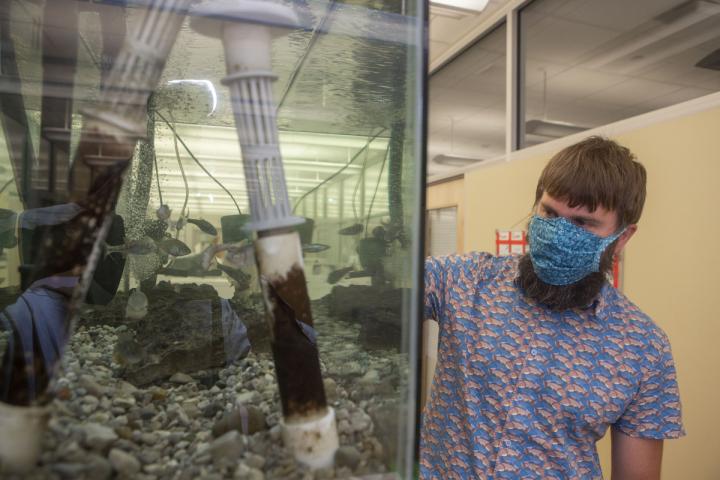Spring storms don’t serve as a trigger for steelhead migration, UC study finds

Credit: Joseph Fuqua II/UC Creative
An endangered fish in California might use its internal clock to decide when to migrate, according to a study by the University of Cincinnati.
UC visiting assistant professor of biology Michael Booth studied the migration patterns of steelhead, a subpopulation of rainbow trout that migrates to the Pacific Ocean, where the growing fish hunt and feed until they return to their natal freshwater streams to spawn.
While working at the United Water Conservation District, Booth used 19 years of records from a designated fish trap on southern California’s Santa Clara River to identify potential environmental drivers that spur some fish to make the arduous trip to the Pacific Ocean. The trap is part of a diversion off the river where fish can be counted and, if necessary, relocated downstream past the river’s low or dry spots.
He found that steelhead migration was triggered by the lengthening daylight of spring rather than factors like recent rains, which had little correlation to migration.
The study was published in the North American Journal of Fisheries Management.
The Santa Clara River is one of the largest coastal watersheds in southern California. It’s an important source of water for Ventura County’s $2 billion agriculture industry, famed for its strawberries, lemons, peppers and avocados.
But sections of the river often go dry completely, isolating fish in upstream tributaries until the seasonal rains return.
“The Santa Clara River is a massive desert river,” Booth said. “The river channel is braided with sand and gravel. It’s about 1,000 feet wide in its lower sections and it’s always changing.”
The river is fed by cold-water mountain streams typically associated with rainbow trout. Some of the fish remain in these tributaries their entire lives, spawning and dying not far from where they hatched. Others undergo physiological changes that allow them to tolerate the saltwater of the Pacific Ocean. While rainbow trout are typically green and pink, steelhead can take on a silvery sheen, giving them their name.
Steelhead in southern California are federally protected as an endangered species. Anglers must release any they catch.
Booth said there are big genetic benefits to making the dangerous trip to the Pacific Ocean. Steelhead grow much faster in the food-rich ocean than trout that remain in the freshwater streams. Fish that migrate to the ocean have an advantage in passing on their genes to subsequent generations when they return to spawn, he said.
“A 3-year-old resident trout might be a foot long, but a steelhead might be 3 feet long,” he said. “Their fecundity is directly related to size. So the bigger the fish, the more eggs it can make. There’s a really strong genetic advantage to making more babies.”
The study recommended limiting the extraction of water from the Santa Clara River during the migration months of mid-March to May. Likewise, Booth said the water flow in the river should be maintained where possible to allow late migrating steelhead to return upstream.
The trout’s migration opportunities might shrink from climate change, the study warned.
“There are a lot of challenges in the Santa Clara River. The water levels go up and down,” he said. “This river has a massive sediment load. During a big storm, the river bed can erode 20 feet. The water looks like a smoothie coming downstream.”
Booth said steelheads likely wait for sediment-choked river water to settle before migrating.
Since the river in most years is only navigable after storms get water flowing again, Booth hypothesized that heavy rains triggered the steelhead’s movement to the ocean.
“We thought the fish would migrate when the river was flowing and wouldn’t migrate in years without storm events,” Booth said. “It turned out that wasn’t the case. They migrated regardless of whether the river was flowing to the ocean.”
Booth isn’t sure if the fish that reach dry spots head back upstream or simply perish in the main stem of the river.
The study is significant because it could help wildlife managers and government regulators make more informed decisions about water use. The Santa Clara River is a major source of water for agriculture and people who live in the watershed. Knowing what months are crucial for steelhead migration could help wildlife managers avoid conflicts.
“It’s really hard for a water manager to decide this is when we can and can’t divert water if you have no data on when the fish are migrating,” Booth said.
For fish that miss the narrow window to navigate the Santa Clara while it’s running, there are few practical solutions, Booth said.
“This is a very wicked problem. The water available is dependent on rain, snowfall and the recharge of the groundwater,” he said. “We can avoid taking water from the river or reducing extractions but there isn’t an extra water source to make the river flow during droughts.”
But Booth is optimistic the steelhead will persist in the Santa Clara River, at least for now.
“Steelhead are very resilient. They’ve been holding on for a while,” he said
###
Media Contact
Michael Miller
[email protected]
Original Source
https:/
Related Journal Article
http://dx.




